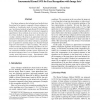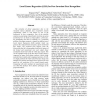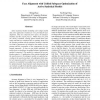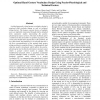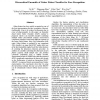115
click to vote
FGR
2006
IEEE
15 years 4 months ago
2006
IEEE
Non-linear subspaces derived using kernel methods have been found to be superior compared to linear subspaces in modeling or classification tasks of several visual phenomena. Such...
119
click to vote
FGR
2006
IEEE
15 years 4 months ago
2006
IEEE
The variation of facial appearance due to the viewpoint (/pose) degrades face recognition systems considerably, which is well known as one of the bottlenecks in face recognition. ...
132
click to vote
FGR
2006
IEEE
15 years 4 months ago
2006
IEEE
Automatic extraction of facial feature deformations (either due to identity change or expression) is a challenging task and could be the base of a facial expression interpretation...
112
click to vote
FGR
2006
IEEE
15 years 4 months ago
2006
IEEE
Active statistical models including active shape models and active appearance models are very powerful for face alignment. They are composed of two parts: the subspace model(s) an...
125
click to vote
FGR
2006
IEEE
15 years 4 months ago
2006
IEEE
A global approach to hand gesture vocabulary design is proposed which includes human as well as technical design factors. The human centered desires of multiple users are implicit...
119
click to vote
FGR
2006
IEEE
15 years 4 months ago
2006
IEEE
We address the task of accurately localizing the eyes in face images extracted by a face detector, an important problem to be solved because of the negative effect of poor localiz...
130
click to vote
FGR
2006
IEEE
15 years 4 months ago
2006
IEEE
Gabor feature has been widely recognized as one of the best representations for face recognition. However, traditionally, it has to be reduced in dimension due to curse of dimensi...
115
click to vote
FGR
2006
IEEE
15 years 4 months ago
2006
IEEE
As an extension to prior work by the authors in the area of photometric normalisation for face verification, we apply these algorithms in a component-based framework. In particula...
117
Voted
FGR
2006
IEEE
15 years 4 months ago
2006
IEEE
In Sign Language recognition, one of the problems is to collect enough training data. Almost all of the statistical methods used in Sign Language Recognition suffer from this prob...
134
click to vote
FGR
2006
IEEE
15 years 4 months ago
2006
IEEE
In this paper, we present our newly developed face expression modeling system for expression analysis and identification. Given a face image at a front view, a realistic facial mo...
